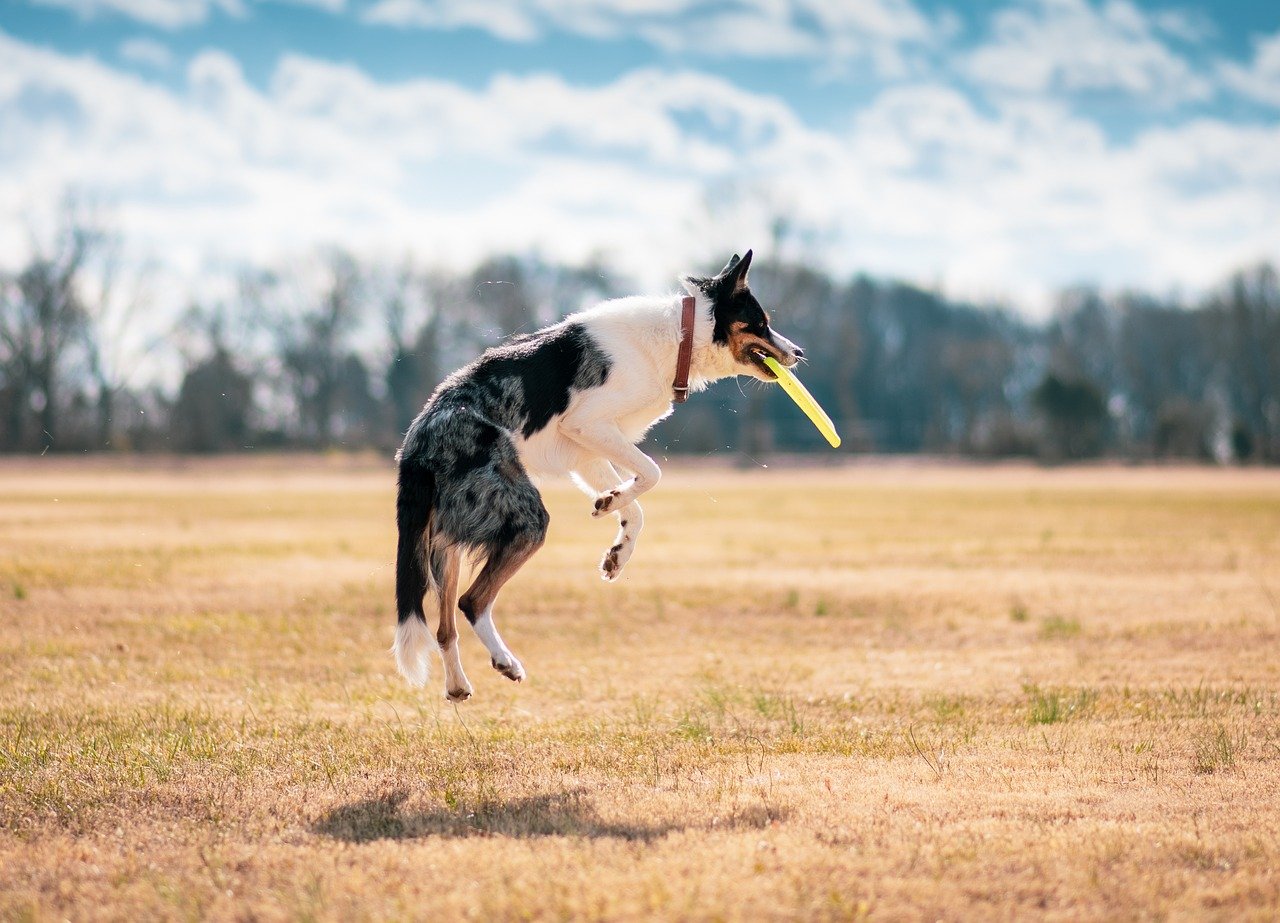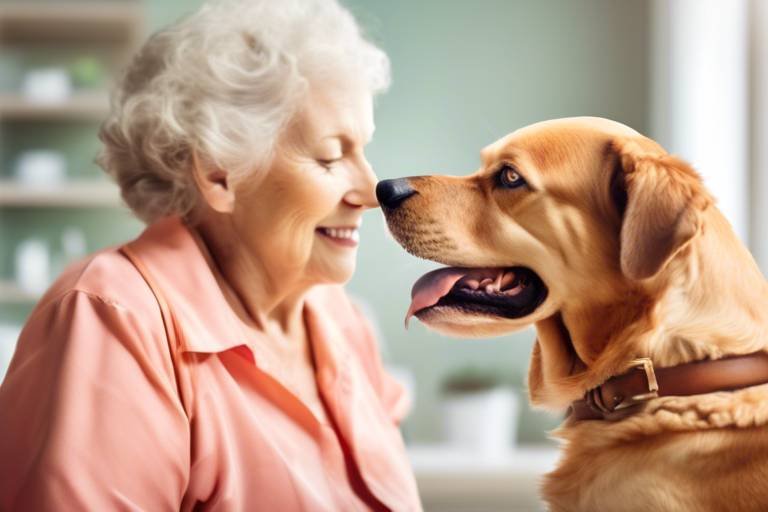The Importance of Monitoring Senior Pet Behavior Changes
Understanding the behavioral changes in senior pets is crucial for their health and well-being. As our beloved furry companions age, they may not only slow down physically but also experience shifts in their behavior that can be subtle yet significant. Just like humans, pets can face challenges as they grow older, and these challenges can manifest in various ways, affecting their overall quality of life. The importance of monitoring these changes cannot be overstated; it’s akin to being a detective in your pet's life, observing the clues they give about their health and happiness.
Why should you care about these behavioral changes? Well, think of your pet as a book, and every change in behavior is a new chapter. By paying attention to these chapters, you can catch potential health issues before they escalate. For instance, if your once-active dog suddenly becomes lethargic, it could indicate pain or discomfort that needs addressing. Similarly, if your cat starts hiding more often, it might be a sign of anxiety or illness. By being vigilant, you can ensure that your senior pet leads a fulfilling life, filled with love and enjoyment.
Moreover, monitoring behavior changes is not just about identifying problems; it’s about enhancing your pet's quality of life. Regular observations can help you tailor their environment and routine to better suit their needs. For example, if you notice that your senior dog struggles with stairs, you might consider rearranging your home to minimize these challenges. Or, if your cat seems less interested in playtime, introducing gentle interactive toys can reignite their spark. These adjustments not only improve their comfort but also strengthen the bond between you and your pet.
In this article, we will delve deeper into the common behavioral changes seen in senior pets, explore the reasons behind these changes, and discuss effective monitoring techniques. By the end, you’ll be equipped with the knowledge to be the best advocate for your aging furry friend. So, let’s embark on this journey together and ensure our senior pets enjoy their golden years to the fullest!
- What are some common behavioral changes in senior pets? Senior pets may show signs of decreased activity, increased sleeping, changes in eating habits, and altered social interactions.
- How can I tell if my pet is in pain? Look for signs such as limping, reluctance to move, excessive grooming of a specific area, or changes in their usual demeanor.
- When should I consult a veterinarian about my pet's behavior changes? If you notice significant changes such as excessive vocalization, hiding, aggression, or any signs of distress, it’s essential to seek veterinary advice.
- Can environmental changes affect my senior pet's behavior? Yes, changes such as moving to a new home or introducing new pets can create stress and anxiety, leading to behavioral shifts.

Recognizing Common Behavioral Changes
As our beloved pets gracefully age, they often undergo a variety of behavioral changes that can signal underlying health issues or shifts in their emotional state. It's essential for pet owners to be vigilant and observant, as these changes can significantly impact their pet's quality of life. From altered eating habits to shifts in social interactions, recognizing these signs early can be the key to ensuring your senior pet remains happy and healthy.
One of the most common changes you might notice is a decrease in activity levels. While it’s normal for older pets to slow down a bit, a sudden drop in their usual playfulness or reluctance to engage in walks could indicate discomfort or pain. Moreover, you might observe changes in their sleeping patterns. Senior pets often sleep more, but if they seem restless or have difficulty settling down, it might be worth investigating further.
Another behavioral change to watch for is altered eating habits. Senior pets may develop a preference for softer food due to dental issues or a decrease in appetite due to health concerns. If you notice your pet is less interested in their meals or is picking at their food, it’s crucial to consult with a veterinarian. Additionally, changes in grooming habits can be a telltale sign; if your pet is neglecting their grooming, it could be a signal of physical discomfort or cognitive decline.
Social behavior is also a significant indicator of how your senior pet is feeling. Many pets become less social as they age, preferring to spend time alone instead of interacting with family members or other pets. This withdrawal can be concerning, especially if it’s accompanied by signs of anxiety or stress. Understanding your pet's typical social behavior is essential for recognizing when something is off.
To help you identify these changes more effectively, here’s a quick reference table summarizing the common behavioral changes in senior pets:
| Behavioral Change | Possible Causes |
|---|---|
| Decreased Activity | Pain, discomfort, or illness |
| Altered Eating Habits | Dental issues, health problems |
| Changes in Grooming | Physical discomfort, cognitive decline |
| Social Withdrawal | Stress, anxiety, health issues |
By keeping an eye on these behavioral changes, you can better understand your senior pet's needs and address any potential issues before they escalate. Remember, early intervention often leads to better outcomes, so don’t hesitate to reach out to your veterinarian if you notice any concerning shifts in behavior.
- What are some signs that my senior pet is in pain?
Look for signs such as limping, reluctance to move, changes in eating habits, or excessive vocalization. - How can I help my pet adjust to behavioral changes?
Maintain a consistent routine, provide a comfortable environment, and consult with your veterinarian for tailored advice. - When should I consider a vet visit for my senior pet?
If you notice significant changes in behavior, eating, or bathroom habits, it's best to consult a veterinarian.

Why Behavioral Changes Occur
Understanding why our beloved senior pets undergo behavioral changes is like peeling back the layers of an onion—each layer reveals something essential about their health and well-being. As pets age, their bodies and minds experience a myriad of changes that can profoundly affect their behavior. These changes are not merely quirks; they often signal underlying issues that require our attention. So, what exactly triggers these behavioral shifts? Let’s dive into some of the primary factors.
One of the most significant influences on a senior pet's behavior is their physical health. As pets grow older, they may develop chronic conditions such as arthritis, diabetes, or even organ dysfunction. These health issues can lead to discomfort, pain, and a general decline in their quality of life. For instance, a dog suffering from arthritis may become less active, avoiding playtime or walks, which were once their favorite activities. Similarly, a cat with dental problems might stop grooming themselves properly, leading to a noticeable change in their demeanor.
Another crucial factor is cognitive decline, akin to dementia in humans. Senior pets can experience a condition known as Cognitive Dysfunction Syndrome (CDS), which can manifest in various ways, including disorientation, disrupted sleep patterns, and changes in social interactions. Imagine your once-playful pup now wandering aimlessly or forgetting where they are—these signs can be heartbreaking for any pet owner. Recognizing these symptoms early can help in providing the right support and care.
Moreover, environmental factors play a significant role in shaping a senior pet’s behavior. Changes in their surroundings, such as moving to a new home, the introduction of new family members, or even the loss of a companion, can create stress and anxiety. It’s essential to understand that pets thrive on routine and familiarity. A sudden change in their environment can lead to confusion and behavioral shifts, such as increased vocalization or withdrawal. For example, a dog that used to greet you at the door with enthusiasm may now hide under the bed when guests arrive, reflecting their anxiety about the new situation.
Lastly, it’s important to consider routine changes. Senior pets often benefit from a consistent daily schedule. Sudden alterations in feeding times, play schedules, or even the way they are walked can lead to disorientation and anxiety. Imagine how unsettling it would be for you if your daily routines were suddenly disrupted—pets feel the same way! Maintaining a stable routine can help mitigate these behavioral changes and provide a sense of security for your aging furry friend.
In summary, behavioral changes in senior pets can stem from a combination of physical health issues, cognitive decline, environmental factors, and routine changes. By understanding these triggers, pet owners can take proactive steps to ensure their senior companions live a happy, healthy, and fulfilling life.
- What are the signs of cognitive decline in senior pets? Look for disorientation, changes in sleeping patterns, and altered social interactions.
- How can I help my senior pet with mobility issues? Consider providing orthopedic beds, ramps, and joint supplements to ease their discomfort.
- When should I consult a veterinarian about my pet's behavior changes? If you notice significant shifts in behavior, such as aggression, hiding, or excessive vocalization, it’s best to seek professional advice.
- Can environmental changes affect my pet's behavior? Yes, moving to a new home or introducing new pets can create stress and lead to behavioral changes.
Physical Health Issues
As our beloved pets age, they often encounter a variety of physical health issues that can significantly impact their behavior and overall quality of life. One of the most common problems is arthritis, a condition that causes inflammation and pain in the joints. Imagine how it feels when your knees ache after a long day; now, picture your furry friend experiencing that discomfort every time they try to jump on the sofa or take a stroll in the park. This pain can lead to a noticeable decrease in activity levels, making your once playful companion seem lethargic or unwilling to engage in their favorite activities.
Another critical aspect of senior pet health is dental problems. Just like humans, pets can suffer from various dental issues, including gum disease and tooth decay. These problems can cause significant pain, leading to changes in eating habits. For instance, a pet that once eagerly devoured their meals may suddenly become hesitant to eat, favoring softer foods or even refusing to eat altogether. This reluctance can also extend to grooming habits, as pets may avoid chewing or licking their bodies due to discomfort.
It's essential to recognize that these physical health issues can manifest in several ways, and being observant is key. Here are some common signs that may indicate your senior pet is experiencing health problems:
- Changes in Activity Level: Notice if your pet is less active or seems reluctant to play.
- Altered Eating Habits: Watch for changes in appetite or specific preferences for certain types of food.
- Unusual Behavior: Look out for signs of aggression, withdrawal, or excessive vocalization, which can indicate pain or discomfort.
By keeping a close eye on these changes, you can take proactive steps to address potential health issues before they escalate. Regular veterinary check-ups are crucial as they can help identify these problems early on. During these visits, your veterinarian may conduct physical examinations, dental cleanings, and even blood tests to ensure your pet remains healthy and happy in their golden years. Remember, your observation and timely action can make all the difference in your senior pet's life.
Q: How can I tell if my senior pet is in pain?
A: Look for signs such as changes in behavior, reluctance to move, excessive grooming of a specific area, or vocalization when touched. If you suspect pain, consult your veterinarian.
Q: Are there specific diets recommended for senior pets?
A: Yes, many veterinarians suggest diets that are lower in calories but higher in fiber to help maintain a healthy weight and support digestion in senior pets.
Q: How often should senior pets see the veterinarian?
A: Senior pets should ideally have check-ups every six months. This allows for early detection of health issues and ensures they receive appropriate care.
Arthritis and Mobility
Arthritis is a common affliction among senior pets, and it can dramatically impact their mobility and overall quality of life. Imagine waking up one day and feeling a dull ache in your joints; that's what our furry friends experience as they age. This discomfort can lead to a reluctance to engage in activities they once loved, such as playing fetch or taking long walks. It's crucial for pet owners to recognize the signs of arthritis early on so they can take proactive measures.
Some of the most common signs of arthritis in pets include:
- Reluctance to Move: If your pet hesitates to jump onto the couch or climb stairs, it could be a sign of joint pain.
- Changes in Activity Levels: A once-active pet may become lethargic, preferring to lie down rather than play.
- Difficulty in Grooming: If your pet is unable to groom themselves properly, it may be due to discomfort in their joints.
- Noticeable Limping: A limp or altered gait can indicate pain in the joints, requiring immediate attention.
Understanding these signs is just the first step; addressing them is where the real challenge lies. Regular veterinary check-ups are essential for diagnosing arthritis through physical examinations and possibly X-rays. Once diagnosed, there are various treatment options available, including medication, physical therapy, and even weight management. Keeping your pet at a healthy weight can alleviate some pressure on their joints, making it easier for them to move around comfortably.
Additionally, consider making adjustments in your home to accommodate your pet's mobility issues. Simple changes like providing ramps or non-slip mats can make a world of difference. Remember, your senior pet may not vocalize their discomfort, so it's up to you to be their advocate. By staying vigilant and observant, you can ensure that your beloved companion enjoys their golden years with as much comfort and joy as possible.
- What are the common symptoms of arthritis in senior pets? Symptoms include reluctance to move, changes in activity levels, difficulty in grooming, and noticeable limping.
- How is arthritis diagnosed in pets? Diagnosis typically involves a physical examination by a veterinarian and may include X-rays to assess joint health.
- What treatment options are available for pets with arthritis? Treatment can include medication, physical therapy, weight management, and home modifications.
- Can diet affect my pet's arthritis? Yes, a balanced diet that maintains a healthy weight can help alleviate pressure on the joints.
Dental Problems
As our furry companions age, dental health often takes a backseat, yet it plays a pivotal role in their overall well-being. Many pet owners may not realize that dental problems can lead to significant behavioral changes in senior pets. For instance, a pet suffering from dental pain may become less enthusiastic about eating or even show reluctance to engage in play. Imagine if you had a toothache; it would be hard to enjoy your favorite meal or even smile! Similarly, your pet’s discomfort can manifest in various ways, and recognizing these signs is crucial.
Common dental issues in senior pets include:
- Periodontal Disease: This is an infection of the tissues that support the teeth, often caused by plaque buildup. It can lead to tooth loss and severe pain.
- Tooth Decay: Just like humans, pets can suffer from cavities, which can be painful and lead to further complications.
- Oral Tumors: These can form in the mouth and may be benign or malignant, causing discomfort and affecting eating habits.
When dental problems arise, you might notice a change in your pet's behavior. They may become more irritable or withdrawn, preferring to stay in their cozy spot rather than interact with you or other pets. Additionally, you might observe changes in their grooming habits; a pet in pain might neglect their usual grooming routine, leading to a less tidy appearance. If you notice your pet is avoiding their favorite crunchy treats or only eating soft food, it could be a red flag that something is amiss in their mouth.
Regular dental check-ups are essential, particularly for senior pets. A veterinarian can provide professional cleanings and check for any signs of dental disease. Think of it as a spa day for your pet's mouth! Early intervention can prevent more severe health issues down the line, not just in the mouth but also in other organs, as dental disease can lead to systemic infections. So, make sure to keep those pearly whites in check!
In conclusion, paying attention to your senior pet's dental health can significantly impact their quality of life. By recognizing the signs of dental problems early and ensuring regular veterinary visits, you can help your furry friend maintain their health and happiness well into their golden years.
- How often should I have my senior pet's teeth checked? It's recommended to have their teeth checked at least once a year, but more frequent visits may be necessary depending on their dental health.
- What are the signs that my pet may have dental problems? Look for signs such as bad breath, difficulty eating, swollen gums, or excessive drooling.
- Can I brush my senior pet's teeth at home? Yes! Regular brushing can help maintain dental health, but be sure to use toothpaste specifically designed for pets.
Cognitive Decline
As our beloved pets age, just like humans, they can experience , which is akin to dementia. This condition, known as Cognitive Dysfunction Syndrome (CDS), can lead to significant changes in behavior that pet owners should be aware of. Imagine your pet, who once greeted you at the door with excitement, now seeming confused or disoriented. This transformation can be heart-wrenching, but understanding it is the first step in providing the necessary care.
CDS can manifest in various ways, and recognizing these symptoms early can make a world of difference. Some common signs include:
- Disorientation: Pets may get lost in familiar places, stare blankly at walls, or forget where their food bowl is.
- Altered Sleep Patterns: You might notice your pet sleeping more during the day and being restless at night, leading to disrupted sleep for both of you.
- Changes in Interaction: Your once sociable pet may become withdrawn, showing less interest in playtime or cuddles.
- Increased Anxiety: Senior pets may become more anxious or fearful, reacting negatively to loud noises or sudden movements.
It's essential to note that these changes are not just a part of aging; they can indicate underlying health issues that require attention. For instance, a pet that suddenly becomes aggressive or overly vocal might be struggling with discomfort or confusion. This is why monitoring your pet's behavior closely is vital. Keeping a record of these changes can help you identify patterns and discuss them with your veterinarian.
Moreover, the emotional toll on both pets and their owners can be significant. Watching a beloved companion struggle with cognitive decline can be heartbreaking. However, there are ways to support your pet through this challenging time. Engaging in mental stimulation activities, such as puzzle toys or training exercises, can help keep their minds sharp. Additionally, maintaining a consistent routine can provide a sense of security and familiarity for your aging pet.
In summary, cognitive decline in senior pets is a serious issue that requires attention and care. By recognizing the signs and implementing supportive measures, you can help your furry friend navigate this difficult phase of life with dignity and comfort.
Q: How can I tell if my pet is experiencing cognitive decline?
A: Look for signs such as disorientation, changes in sleep patterns, altered interactions with family members, and increased anxiety. Keeping a behavior journal can help track these changes.
Q: Are there treatments available for cognitive decline in pets?
A: Yes, there are various treatments, including medications and supplements that can help manage symptoms. Additionally, engaging your pet in mental activities can be beneficial.
Q: Should I consult a veterinarian if I notice these changes?
A: Absolutely! It's crucial to consult a veterinarian if you notice any significant behavioral changes in your senior pet. They can help determine if there are underlying health issues and suggest appropriate interventions.
Q: Can cognitive decline be prevented?
A: While you cannot completely prevent cognitive decline, providing a stimulating environment, regular exercise, and routine veterinary check-ups can help maintain your pet's cognitive health.

Environmental Factors Influencing Behavior
When it comes to our beloved senior pets, the environment plays a significant role in their overall behavior and well-being. Just like humans, pets are sensitive to changes in their surroundings, and these alterations can lead to noticeable shifts in their behavior. For instance, moving to a new home can be akin to uprooting a plant; it may take time for them to adjust to the new soil. Similarly, the arrival of new pets or even changes in the household routine can create stress and anxiety for our aging companions.
One of the most common environmental changes that can affect senior pets is the introduction of new family members, whether they be human or animal. Imagine being a senior dog or cat, used to a quiet home, and suddenly finding yourself sharing your space with a boisterous puppy or a curious kitten. This can lead to feelings of insecurity and territorial behavior. It’s crucial to monitor how your senior pet reacts to these changes. Are they hiding more often? Have they become less social? These could be signs that they are feeling overwhelmed.
Another factor to consider is the routine. Senior pets thrive on consistency, and any abrupt changes can lead to confusion. For example, if their feeding schedule is altered or if they are suddenly taken for walks at different times, this can disrupt their sense of security. Maintaining a regular routine helps them feel more at ease and can significantly reduce anxiety levels. Think of it as a comforting rhythm in their daily lives; when that rhythm is disrupted, it can be quite distressing.
Furthermore, environmental stressors such as loud noises, unfamiliar smells, or even the presence of strangers can impact a senior pet's behavior. Many older animals may develop sensitivity to sounds that they previously ignored, leading to increased anxiety or fear. For instance, fireworks or thunderstorms can be particularly distressing for them. Observing their reactions during such events can provide insight into their comfort levels and help you create a more peaceful environment.
To summarize, the environment significantly influences senior pet behavior. It's important for pet owners to be vigilant and aware of how changes in their surroundings can affect their furry friends. By recognizing these influences, we can take proactive steps to ensure our senior pets feel secure and happy in their homes. This may include creating safe spaces, maintaining routines, and being mindful of their reactions to new stimuli. Remember, a little attention to their environment can go a long way in enhancing their quality of life.
- What are some signs that my senior pet is stressed due to environmental changes?
Look for signs such as excessive hiding, changes in eating habits, increased vocalization, or aggression towards other pets or people. - How can I help my senior pet adjust to a new environment?
Introduce changes gradually, maintain a consistent routine, and provide safe spaces where they can retreat when feeling overwhelmed. - Are there specific environmental factors that are more stressful for senior pets?
Yes, factors like loud noises, the arrival of new pets, and significant changes in household routines can all contribute to stress in senior pets.
Stress and Anxiety
As our beloved pets age, they may experience heightened levels of , which can manifest in various ways. Just like humans, senior pets can feel overwhelmed by changes in their environment, leading to behavioral shifts that can be concerning for pet owners. Imagine moving to a new house or introducing a new family member; these situations can be stressful for your furry friend, causing them to feel insecure and anxious.
It's essential to recognize the signs of stress in senior pets. They might start acting more withdrawn, hiding in corners, or even becoming more vocal than usual. You may notice changes in their eating habits, such as refusing to eat or overeating as a coping mechanism. Other signs can include excessive grooming or destructive behavior, which are often attempts to relieve their anxiety. Understanding these behaviors is crucial for providing the comfort and support they need during this challenging time.
To help manage stress and anxiety in senior pets, consider the following strategies:
- Maintain a Consistent Routine: Senior pets thrive on routine. Keeping feeding, walking, and playtime consistent can help them feel secure.
- Create a Safe Space: Designate a quiet area in your home where your pet can retreat when they feel overwhelmed. This could be a cozy bed in a quiet room or a crate with their favorite blanket.
- Provide Enrichment Activities: Engage your pet with gentle toys, puzzle feeders, or low-stress games that stimulate their mind without overwhelming them.
Moreover, understanding the environmental triggers that cause stress is vital. For example, loud noises from fireworks or thunderstorms can be particularly distressing for senior pets. If you notice your pet becoming anxious during these events, consider using calming aids such as anxiety wraps or pheromone diffusers, which can create a more soothing atmosphere.
In conclusion, being observant and proactive about your senior pet's stress and anxiety can significantly enhance their quality of life. By recognizing the signs and implementing strategies to alleviate their discomfort, you can help your furry friend navigate their golden years with more joy and less anxiety.
- What are the common signs of stress in senior pets? Look for changes in behavior such as hiding, excessive vocalization, changes in appetite, or destructive actions.
- How can I help my senior pet with anxiety? Establish a consistent routine, create a safe space, and provide enrichment activities to help manage their anxiety.
- When should I consult a veterinarian about my pet's anxiety? If your pet's anxiety leads to severe behavioral changes or distress, it's essential to seek professional advice.
Routine Changes
Maintaining a consistent routine is essential for the well-being of senior pets. Just like humans, pets thrive on predictability, and any sudden alterations in their daily schedule can lead to confusion and anxiety. Imagine waking up one morning to find that your entire day has been flipped upside down; that’s how your furry friend might feel if their routine suddenly changes. Senior pets are particularly vulnerable to stress, and even minor shifts in their environment or daily activities can be overwhelming.
For instance, if you typically feed your pet at 8 AM and suddenly switch to 10 AM, your pet might become anxious or exhibit signs of distress. This change might lead to them pacing around the house, whining, or even refusing to eat. It's crucial to understand that your senior pet may not adapt to changes as quickly as they once did. Thus, keeping their routine as stable as possible can help minimize these stressors.
Here are a few key areas to focus on when considering routine changes:
- Feeding Schedule: Try to feed your pet at the same times each day. This consistency not only helps with their digestion but also gives them a sense of security.
- Walks and Exercise: Regular walks at the same times can help maintain their physical health and mental stimulation. If you need to change the time, try to do it gradually.
- Playtime: Engage in play at similar times to create a routine that your pet can look forward to. This is vital for their mental health.
Additionally, if you need to introduce a new pet or change the living arrangements, it’s best to do so gradually. Allow your senior pet to adjust at their own pace. You might consider setting up a separate space for the new pet initially, so your senior can explore the changes without feeling overwhelmed. Monitoring their reactions during these transitions is key; if they seem stressed, it may be necessary to revert to the previous routine for a bit longer.
Remember, the goal is to create a calm and predictable environment for your senior pet. By being mindful of their needs and sticking to a routine, you can significantly enhance their quality of life. And who knows? A little consistency might just bring back that sparkle in their eyes!
Q: How can I tell if my senior pet is stressed due to routine changes?
A: Look for signs such as excessive vocalization, hiding, changes in appetite, or increased aggression. If you notice these behaviors, it might be time to reassess any recent changes you've made.
Q: What should I do if my pet refuses to eat after a routine change?
A: Try to revert to their previous feeding schedule and see if they regain their appetite. If the issue persists, consult your veterinarian to rule out any health concerns.
Q: Can I introduce new activities to my senior pet's routine?
A: Yes, but do so gradually. Start with short sessions of new activities and monitor your pet's response. If they seem to enjoy it, you can slowly incorporate it into their routine.

Monitoring Tools and Techniques
Monitoring your senior pet's behavior is not just a good idea; it's essential for their well-being. With age comes a myriad of changes, and keeping an eye on these shifts can make a world of difference. So, how do you go about this? There are several effective tools and techniques that can help you track your furry friend’s behavior and health.
First and foremost, behavior journals can be incredibly useful. Imagine having a diary dedicated to your pet's daily activities, moods, and eating habits. By jotting down observations, you can identify patterns over time. For example, if your once-active dog suddenly becomes lethargic, noting this change could prompt a visit to the vet. It's like being a detective for your pet's health!
In addition to journals, technology aids have revolutionized the way we monitor our pets. Devices such as pet cameras allow you to observe your pet's behavior when you're not home. This can be particularly useful if you're concerned about anxiety or destructive tendencies. You can also use health monitoring devices that track activity levels and vital signs, providing you with real-time data about your pet's health. Imagine being able to check your pet's heart rate or activity level right from your smartphone!
To give you a clearer picture, here's a simple
| Tool | Description | Benefits |
|---|---|---|
| Behavior Journal | A notebook for tracking daily activities and changes. | Helps identify patterns and significant changes in behavior. |
| Pet Cameras | Devices that allow you to watch your pet remotely. | Provides insights into behavior when you're not home. |
| Health Monitoring Devices | Wearable technology that tracks vital signs. | Offers real-time health data and alerts for abnormalities. |
Combining these tools can create a comprehensive monitoring system for your senior pet. However, it’s important to remember that technology should complement, not replace, your intuition as a pet owner. Regularly observing your pet during interactions can help you notice subtle changes that a device might miss. After all, you know your pet better than anyone else!
Lastly, discussing your observations with your veterinarian can lead to tailored advice for your pet’s specific needs. They can help interpret any data you’ve collected and suggest further steps if necessary. Think of it as a team effort—your pet, you, and the vet working together to ensure a happy, healthy life for your furry companion.
- How often should I monitor my senior pet's behavior?
It's best to monitor your pet daily, especially if they are showing signs of behavioral changes. Regular observations can help you catch any issues early.
- What should I do if I notice significant behavioral changes?
If you notice significant changes, it’s important to consult your veterinarian as soon as possible. They can help determine if there are underlying health issues.
- Can technology really help in monitoring my pet's health?
Absolutely! Technology like pet cameras and health monitors can provide valuable insights into your pet's behavior and health, making it easier to spot changes.
Behavior Journals
Keeping a behavior journal for your senior pet is not just a trendy idea; it's a game changer for understanding your furry friend better. Think of it as a diary for your pet's daily life, where you can jot down everything from their eating habits to their mood swings. By documenting these details, you can spot patterns and changes that might otherwise go unnoticed. This becomes especially important as your pet ages, as subtle shifts in behavior may indicate underlying health issues that need addressing.
So, what exactly should you include in this journal? Here are some key elements to consider:
- Daily Activities: Note the times your pet eats, sleeps, and plays. Are they more lethargic than usual? Are they engaging in their favorite activities?
- Eating Habits: Track any changes in appetite. Is your pet eating less, or perhaps more than usual? Changes in eating can be a significant indicator of health problems.
- Social Interactions: Document how your pet interacts with family members and other pets. Are they becoming more withdrawn or aggressive?
- Mood Changes: Pay attention to your pet's mood. Are they more anxious, fearful, or irritable? Recognizing these emotional shifts can help you provide the right support.
By regularly updating your behavior journal, you create a comprehensive picture of your pet's well-being. This information can be incredibly valuable during veterinary visits, as it provides your vet with insights into your pet's daily life that they might not otherwise see. You can present this journal as a tool for collaboration, making it easier for your veterinarian to diagnose and treat any concerns.
Moreover, maintaining a behavior journal isn't just beneficial for your pet; it can also foster a deeper bond between you and your furry companion. As you become more attuned to their needs and habits, you'll find yourself becoming a more proactive and informed pet owner. Plus, it can be a fun activity! You might even discover quirky habits and preferences that make your pet uniquely lovable.
In conclusion, a behavior journal is an essential tool for monitoring your senior pet's well-being. By dedicating time to observe and record their behavior, you can ensure that they receive the best possible care as they age. Remember, your pet relies on you to be their voice, and a behavior journal can help you speak up for their needs.
Q: How often should I update the behavior journal?
A: It's best to update the journal daily or at least several times a week to capture any changes promptly.
Q: What should I do if I notice significant changes in my pet's behavior?
A: If you observe significant changes, consult your veterinarian as soon as possible to discuss your findings and seek professional advice.
Q: Can I use a digital app for tracking my pet's behavior?
A: Absolutely! There are many apps designed for pet owners that can help you track your pet's behavior, health, and appointments.
Technology Aids
Understanding the behavioral changes in senior pets is crucial for their health and well-being. This article explores the significance of these changes and how to effectively monitor them.
As pets age, they may exhibit various behavioral changes. Identifying these common signs early can help in addressing potential health issues and ensuring a better quality of life for senior pets.
Behavioral changes in senior pets can be attributed to various factors, including physical health, cognitive decline, and environmental changes. Understanding the root causes is essential for proper care and intervention.
Many senior pets experience health issues that can affect their behavior. Pain, discomfort, or illness may lead to changes in activity levels, eating habits, and social interactions.
Arthritis is a common condition in senior pets that can significantly impact their mobility. Recognizing signs of discomfort can help pet owners take proactive measures to improve their pet's quality of life.
Dental health is often overlooked in senior pets, yet it can lead to significant behavioral changes. Pain from dental issues can cause reluctance to eat or changes in grooming habits.
Cognitive decline, similar to dementia in humans, can affect senior pets. Recognizing the symptoms of cognitive dysfunction syndrome (CDS) is vital for providing appropriate support and care.
Changes in a pet's environment can also lead to behavioral shifts. Factors such as moving to a new home, the arrival of new pets, or changes in routine can create stress for senior animals.
Senior pets may become more anxious due to changes in their surroundings. Identifying stress triggers can help owners create a more comfortable and secure environment for their aging pets.
Maintaining a consistent routine is essential for senior pets. Sudden changes in feeding, walking, or playtime can lead to confusion and anxiety, impacting their overall behavior.
Effective monitoring of senior pet behavior can be achieved through various tools and techniques. Keeping detailed records and utilizing technology can aid in recognizing patterns and changes.
In today's digital age, technology has become a powerful ally for pet owners, particularly when it comes to monitoring the behavior of senior pets. Devices like pet cameras and health monitoring gadgets can provide invaluable insights into how your furry friend is doing when you're not around. Imagine being able to check in on your pet during the day, seeing if they are active or resting comfortably. This can be particularly reassuring if you have to leave them alone for extended periods.
For instance, pet cameras allow you to observe your pet's behavior in real-time, enabling you to notice any unusual habits or signs of distress. Some advanced models even have two-way audio, allowing you to speak to your pet and comfort them if they seem anxious. Additionally, health monitoring devices can track vital signs such as heart rate and activity levels, alerting you to any significant changes that may require veterinary attention.
Here’s a quick overview of some popular technology aids:
| Device Type | Purpose | Benefits |
|---|---|---|
| Pet Cameras | Monitor behavior | Real-time viewing and two-way communication |
| Health Monitors | Track vital signs | Alerts for unusual changes |
| GPS Trackers | Locate your pet | Peace of mind during walks or outings |
By integrating these technological tools into your routine, you can be more proactive in recognizing behavioral changes in your senior pet. The earlier you identify potential issues, the better equipped you'll be to seek help and ensure your beloved companion enjoys a happy, healthy life.
Knowing when to seek professional help is crucial for senior pet care. Understanding the signs that indicate a need for veterinary consultation can ensure timely intervention and treatment.
Recognizing signs of distress, such as excessive vocalization, hiding, or aggression, is essential. These behaviors may indicate underlying health issues that need immediate attention from a veterinarian.
Regular veterinary check-ups are vital for senior pets. Routine examinations can help detect health problems early, allowing for timely treatment and better management of behavioral changes.
- How can I tell if my senior pet is in pain? Look for changes in behavior, such as increased aggression, withdrawal, or reluctance to move.
- What should I do if I notice sudden behavioral changes? Document the changes and consult your veterinarian for guidance.
- Are there specific diets for senior pets? Yes, many brands offer specialized diets that cater to the nutritional needs of senior pets.

When to Consult a Veterinarian
Knowing when to seek professional help for your senior pet is crucial. Just like humans, our furry friends can experience a variety of health issues as they age, and recognizing the signs early can make a world of difference. So, what should you be looking out for? It's all about being observant and proactive. If you notice any unusual behavior, it’s time to take action.
One of the most significant indicators that your pet may need veterinary attention is a change in their behavioral patterns. For instance, if your once playful pup suddenly becomes lethargic or disinterested in activities they used to love, it could be a sign of something more serious. Similarly, if your cat, who typically greets you at the door, starts hiding or avoiding interaction, this could indicate distress or discomfort.
Here are some specific signs that should prompt a visit to the vet:
- Excessive vocalization: If your pet starts to vocalize more than usual, it could be a cry for help.
- Changes in appetite: A sudden increase or decrease in eating habits can signify underlying health issues.
- Hiding or withdrawal: If your pet is isolating themselves, it might be due to pain or anxiety.
- Unexplained aggression: If your gentle giant suddenly becomes aggressive, it’s essential to investigate the cause.
Additionally, keep an eye on their grooming habits. Senior pets may neglect their grooming due to pain or discomfort, which can lead to further health complications. If you find that your pet's coat is becoming matted or dirty, or if they are refusing to groom themselves, this could be a red flag.
Regular health check-ups are also vital for senior pets. These visits allow your veterinarian to conduct routine examinations that can help detect potential health problems early on. During these check-ups, your vet may perform blood tests, dental exams, and physical assessments to ensure your pet is in good health. Remember, prevention is always better than cure!
In summary, being attentive to your senior pet’s behavior can lead to timely veterinary interventions that can greatly enhance their quality of life. By recognizing the signs of distress and maintaining regular veterinary visits, you can ensure your beloved companion receives the care they need as they age.
Q: How often should I take my senior pet to the veterinarian?
A: It's generally recommended to take senior pets to the vet at least twice a year for check-ups. However, if your pet has existing health issues, your vet may suggest more frequent visits.
Q: What should I do if my pet is showing signs of pain?
A: If you suspect your pet is in pain, contact your veterinarian immediately. They can assess the situation and recommend appropriate treatment options.
Q: Are there specific dietary needs for senior pets?
A: Yes! Senior pets often require a diet that is lower in calories but higher in fiber to help maintain a healthy weight and support digestion. Consult your vet for tailored dietary recommendations.
Signs of Distress
Understanding the behavioral changes in senior pets is crucial for their health and well-being. This article explores the significance of these changes and how to effectively monitor them.
As pets age, they may exhibit various behavioral changes. Identifying these common signs early can help in addressing potential health issues and ensuring a better quality of life for senior pets.
Behavioral changes in senior pets can be attributed to various factors, including physical health, cognitive decline, and environmental changes. Understanding the root causes is essential for proper care and intervention.
Many senior pets experience health issues that can affect their behavior. Pain, discomfort, or illness may lead to changes in activity levels, eating habits, and social interactions.
Arthritis is a common condition in senior pets that can significantly impact their mobility. Recognizing signs of discomfort can help pet owners take proactive measures to improve their pet's quality of life.
Dental health is often overlooked in senior pets, yet it can lead to significant behavioral changes. Pain from dental issues can cause reluctance to eat or changes in grooming habits.
Cognitive decline, similar to dementia in humans, can affect senior pets. Recognizing the symptoms of cognitive dysfunction syndrome (CDS) is vital for providing appropriate support and care.
Changes in a pet's environment can also lead to behavioral shifts. Factors such as moving to a new home, the arrival of new pets, or changes in routine can create stress for senior animals.
Senior pets may become more anxious due to changes in their surroundings. Identifying stress triggers can help owners create a more comfortable and secure environment for their aging pets.
Maintaining a consistent routine is essential for senior pets. Sudden changes in feeding, walking, or playtime can lead to confusion and anxiety, impacting their overall behavior.
Effective monitoring of senior pet behavior can be achieved through various tools and techniques. Keeping detailed records and utilizing technology can aid in recognizing patterns and changes.
Keeping a behavior journal allows pet owners to track changes over time. Documenting daily activities, eating habits, and mood can highlight significant shifts that may require veterinary attention.
Utilizing technology, such as pet cameras or health monitoring devices, can provide valuable insights into a senior pet's behavior when owners are not present, helping to identify changes more easily.
Knowing when to seek professional help is crucial for senior pet care. Understanding the signs that indicate a need for veterinary consultation can ensure timely intervention and treatment.
Recognizing signs of distress in senior pets is essential for their well-being. These signs can manifest in various ways, and being attentive to them can make a significant difference in your pet's quality of life. For instance, excessive vocalization, such as barking or meowing, can indicate discomfort or anxiety. Additionally, if your pet starts hiding more often or shows aggression towards family members or other pets, these behaviors can signal underlying health issues that require immediate attention.
It's also crucial to observe changes in eating habits. If your furry friend suddenly refuses to eat or shows a lack of interest in their favorite treats, it could be a sign of distress. Other indicators include:
- Increased lethargy or reluctance to engage in activities they once enjoyed.
- Changes in bathroom habits, such as incontinence or frequent accidents indoors.
- Excessive grooming or, conversely, neglecting grooming altogether.
By being vigilant and noting these signs, you can ensure that your senior pet receives the care they need. Don't hesitate to consult with a veterinarian if you notice any of these distress signals, as early intervention can lead to better outcomes.
Regular veterinary check-ups are vital for senior pets. Routine examinations can help detect health problems early, allowing for timely treatment and better management of behavioral changes.
- How often should I take my senior pet to the vet? It's generally recommended to take senior pets for check-ups at least twice a year, as they may require more frequent monitoring.
- What are some common signs of cognitive decline in pets? Common signs include disorientation, disrupted sleep patterns, and changes in social interactions.
- How can I help my pet adjust to changes in their environment? Gradually introduce changes, maintain routines, and provide comfort items like their favorite blanket or toy.
Regular Health Check-ups
When it comes to the health of our senior pets, regular veterinary check-ups are not just a good idea; they are essential. Imagine your beloved furry friend as a fine wine that needs to be carefully monitored as it ages. Just like wine, pets can develop complexities that require attention. As they grow older, their bodies undergo various changes that may not be immediately visible to the naked eye. This is why routine examinations can make a significant difference in their overall health and behavior.
During these check-ups, veterinarians can conduct thorough assessments that include checking vital signs, dental health, and joint mobility. For instance, a simple examination can reveal underlying issues such as arthritis or dental disease, both of which can lead to discomfort and behavioral changes. It's important to remember that senior pets are often masters at hiding their pain. They might not show obvious signs of distress until the issue becomes severe. This is where a trained professional can spot the subtle signs that we might overlook.
Moreover, regular check-ups allow for early detection of potential health problems, which is crucial for effective treatment. For example, conditions such as kidney disease or diabetes can develop silently but can be managed more effectively if caught early. Your vet can recommend a tailored health plan that includes appropriate vaccinations, diet adjustments, and even supplements to support your pet's aging body. This proactive approach can significantly enhance their quality of life.
To give you a better understanding of what to expect during these visits, here’s a brief overview of typical components included in a senior pet check-up:
| Check-up Component | Description |
|---|---|
| Physical Examination | A thorough assessment of your pet's overall health, checking for signs of pain, swelling, or abnormalities. |
| Blood Tests | Routine blood work can help detect issues with organ function and other health concerns. |
| Weight Management | Monitoring weight is crucial; obesity can lead to various health problems. |
| Dental Check | Assessing dental health to prevent pain and infection, which can affect eating habits. |
In conclusion, making regular health check-ups a priority for your senior pet is akin to giving them a ticket to a longer, happier life. These visits are not just about addressing immediate concerns; they are about ensuring your pet’s golden years are filled with comfort and joy. So, don’t wait for a problem to arise. Schedule those check-ups and keep your furry companion thriving!
- How often should I take my senior pet to the vet? It’s generally recommended to schedule check-ups at least twice a year for senior pets.
- What should I do if my pet shows sudden behavioral changes? Consult your veterinarian as soon as possible to rule out any underlying health issues.
- Can I perform health checks at home? While you can monitor some signs like weight and appetite, regular vet visits are crucial for thorough examinations.
Frequently Asked Questions
- What are common behavioral changes in senior pets?
As pets age, they may show signs like increased lethargy, changes in eating habits, or altered social interactions. It's crucial to observe these changes, as they can indicate underlying health issues.
- Why do behavioral changes occur in senior pets?
Behavioral changes can stem from various factors such as physical health problems, cognitive decline, and environmental stressors. Understanding these factors helps in providing better care for your pet.
- How can I monitor my senior pet's behavior effectively?
Keeping a behavior journal is an excellent way to track changes over time. Additionally, using technology like pet cameras can help you observe their behavior when you're not around.
- When should I consult a veterinarian about my senior pet's behavior?
If you notice signs of distress such as excessive vocalization, hiding, or aggression, it’s important to seek veterinary advice. Regular check-ups are also vital for early detection of potential health issues.
- What signs indicate my senior pet might be in pain?
Look for changes in activity levels, reluctance to move, or changes in grooming habits. If your pet seems more withdrawn or irritable, it could be a sign they are experiencing discomfort.
- How can environmental changes affect my senior pet?
Senior pets can be sensitive to changes in their environment, such as moving to a new home or the introduction of new pets. These changes can lead to stress and anxiety, affecting their overall behavior.
- What are the signs of cognitive decline in senior pets?
Symptoms of cognitive dysfunction syndrome (CDS) include disorientation, changes in sleep patterns, and altered social interactions. Recognizing these signs early can help in managing the condition effectively.


















